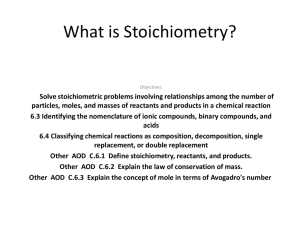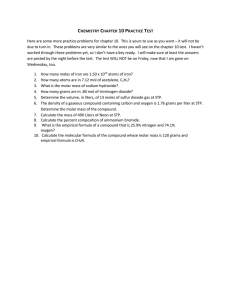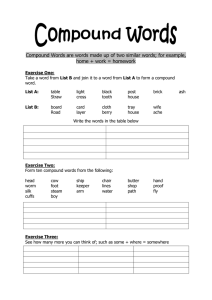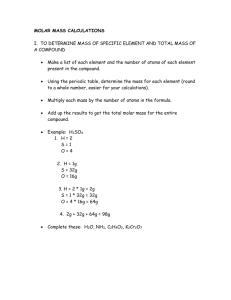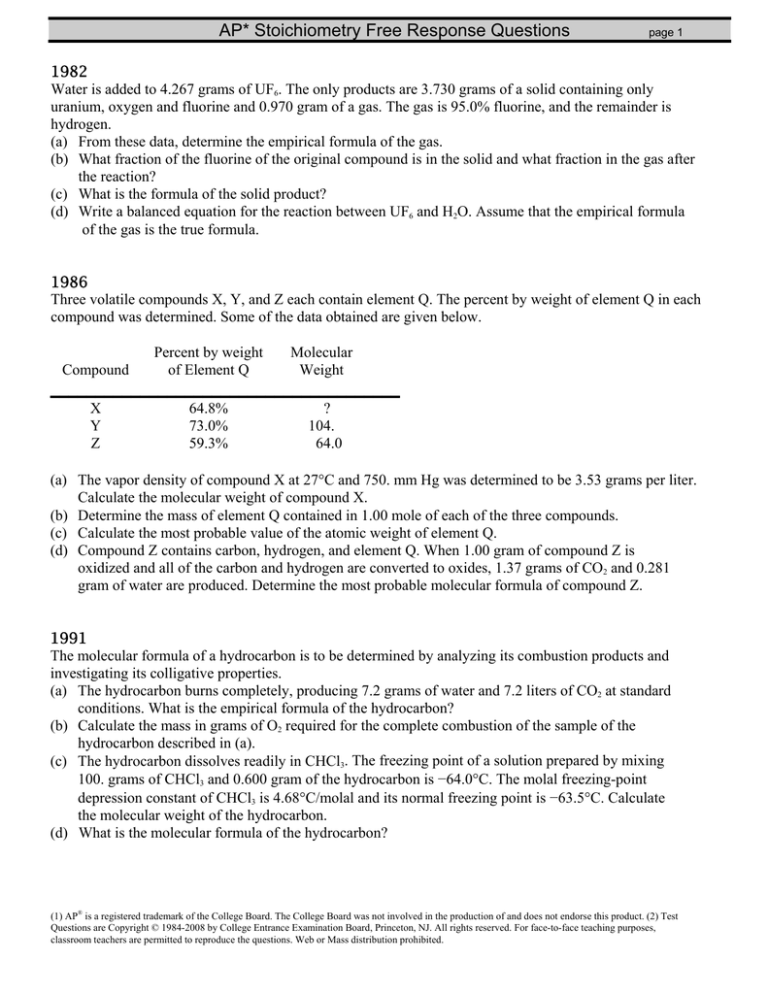
AP* Stoichiometry Free Response Questions
page 1
1982
Water is added to 4.267 grams of UF6. The only products are 3.730 grams of a solid containing only
uranium, oxygen and fluorine and 0.970 gram of a gas. The gas is 95.0% fluorine, and the remainder is
hydrogen.
(a) From these data, determine the empirical formula of the gas.
(b) What fraction of the fluorine of the original compound is in the solid and what fraction in the gas after
the reaction?
(c) What is the formula of the solid product?
(d) Write a balanced equation for the reaction between UF6 and H2O. Assume that the empirical formula
of the gas is the true formula.
1986
Three volatile compounds X, Y, and Z each contain element Q. The percent by weight of element Q in each
compound was determined. Some of the data obtained are given below.
Compound
Percent by weight
of Element Q
Molecular
Weight
_______________________________________ X
Y
Z
64.8%
73.0%
59.3%
?
104.
64.0
(a) The vapor density of compound X at 27°C and 750. mm Hg was determined to be 3.53 grams per liter.
Calculate the molecular weight of compound X.
(b) Determine the mass of element Q contained in 1.00 mole of each of the three compounds.
(c) Calculate the most probable value of the atomic weight of element Q.
(d) Compound Z contains carbon, hydrogen, and element Q. When 1.00 gram of compound Z is
oxidized and all of the carbon and hydrogen are converted to oxides, 1.37 grams of CO2 and 0.281
gram of water are produced. Determine the most probable molecular formula of compound Z.
1991
The molecular formula of a hydrocarbon is to be determined by analyzing its combustion products and
investigating its colligative properties.
(a) The hydrocarbon burns completely, producing 7.2 grams of water and 7.2 liters of CO2 at standard
conditions. What is the empirical formula of the hydrocarbon?
(b) Calculate the mass in grams of O2 required for the complete combustion of the sample of the
hydrocarbon described in (a).
(c) The hydrocarbon dissolves readily in CHCl3. The freezing point of a solution prepared by mixing
100. grams of CHCl3 and 0.600 gram of the hydrocarbon is −64.0°C. The molal freezing-point
depression constant of CHCl3 is 4.68°C/molal and its normal freezing point is −63.5°C. Calculate
the molecular weight of the hydrocarbon.
(d) What is the molecular formula of the hydrocarbon?
(1) AP® is a registered trademark of the College Board. The College Board was not involved in the production of and does not endorse this product. (2) Test
Questions are Copyright © 1984-2008 by College Entrance Examination Board, Princeton, NJ. All rights reserved. For face-to-face teaching purposes,
classroom teachers are permitted to reproduce the questions. Web or Mass distribution prohibited.
1993
AP* Stoichiometry Free Response Questions
page 2
I. 2 Mn2+ + 4 OH− + O2(g) → 2 MnO2(s) + 2 H2O
II. MnO2(s) + 2 I− + 4 H+ → Mn2+ + I2(aq) + 2 H2O
III. 2 S2O32− + I2(aq) → S4O62− + 2 I−
The amount of oxygen, O2, dissolved in water can be determined by titration. First, MnSO4 and NaOH
are added to a sample of water to convert all of the dissolved O2 to MnO2, as shown in equation I
above. Then H2SO4 and KI are added and the reaction represented by equation II proceeds. Finally, the
I2 that is formed is titrated with standard sodium thiosulfate, Na2S2O3, according to equation III.
(a) According to the equation above, how many moles of S2O32− are required for analyzing
1.00 mole of O2 dissolved in water?
(b) A student found that a 50.0-milliliter sample of water required 4.86 milliliters of 0.0112-molar
Na2S2O3 to reach the equivalence point. Calculate the number of moles
of O2 dissolved in this sample.
(c) How would the results in (b) be affected if some I2 were lost before the S2O32− was added? Explain.
(d) What volume of dry O2 measured at 25°C and 1.00 atmosphere of pressure would have to be
dissolved in 1.00 liter of pure water in order to prepare a solution of the same concentration as that
obtained in (b)? (cont.)
(e) Name an appropriate indicator for the reaction shown in equation III and describe the change you
would observe at the end point of the titration.
1998
An unknown compound contains only the three elements C,H, and O. A pure sample of the compound
is analyzed and found to be 65.60 percent C and 9.44 percent H by mass.
(a) Determine the empirical formula of the compound.
(b) A solution of 1.570 grams of the compound in 16.08 grams of camphor is observed to freeze
at a temperature 15.2 Celsius degrees below the normal freezing point of pure camphor.
Determine the molar mass and apparent molecular formula of the compound. (The molal
freezing-point depression constant, Kf, for camphor
is 40.0 kg⋅K⋅mol−1.)
(c) When 1.570 grams of the compound is vaporized at 300 °C and 1.00 atmosphere, the gas
occupies a volume of 577 milliliters. What is the molar mass of the compound based on this
result?
(d) Briefly describe what occurs in solution that accounts for the difference between the results
obtained in parts (b) and (c).
AP* Stoichiometry Free Response Questions
page 3
2000
Answer the following questions about BeC2O4(s) and its hydrate.
(a) Calculate the mass percent of carbon in the hydrated form of the solid that has the formula BeC2O4 • 3H2O
(b) When heated to 220.°C, BeC2O4 • 3 H2O(s) dehydrates completely as represented below.
BeC2O4 • 3 H2O(s) → BeC2O4(s) + 3 H2O(g)
If 3.21 g of BeC2O4 • 3 H2O(s) is heated to 220.°C, calculate
(i) the mass of BeC2O4(s) formed, and,
(ii) the volume of the H2O(g) released, measured at 220.°C and 735 mm Hg.
(c) A 0.345 g sample of anhydrous BeC2O4 , which contains an inert impurity, was dissolved in sufficient
water to produce 100. mL of solution. A 20.0 mL portion of the solution was titrated with KMnO4(aq).
The balanced equation for the reaction that occurred is as follows.
−
+
2−
2+
16 H (aq) + 2 MnO4 (aq) + 5 C2O4 (aq) → 2 Mn (aq) + 10 CO2(g) + 8 H2O(l).
The volume of 0.0150 M KMnO4(aq) required to reach the equivalence point was 17.80 mL.
(i) Identify the reducing agent in the titration reaction.
(ii) For the titration at the equivalence point, calculate the number of moles of each of the
following that reacted.
•
−
MnO4 (aq)
2−
•
C2O4 (aq)
(iii) Calculate the total number of moles of C2O42−(aq) that were present in the 100. mL of
prepared solution.
(iv) Calculate the mass percent of BeC2O4(s) in the impure 0.345 g sample.
2003B
Answer the following questions that relate to chemical reactions.
(a) Iron(III) oxide can be reduced with carbon monoxide according to the following equation.
Fe2O3(s) + 3 CO(g) → 2 Fe(s) + 3 CO2(g)
A 16.2 L sample of CO(g) at 1.50 atm and 200.°C is combined with 15.39 g of Fe2O3(s).
(i) How many moles of CO(g) are available for the reaction?
(ii) What is the limiting reactant for the reaction? Justify your answer with calculations.
(iii) How many moles of Fe(s) are formed in the reaction?
AP* Stoichiometry Free Response Questions
page 4
(b) In a reaction vessel, 0.600 mol of Ba(NO3)2(s) and 0.300 mol of H3PO4(aq) are combined with
deionized water to a final volume of 2.00 L. The reaction represented below occurs.
3 Ba(NO3)2(aq) + 2 H3PO4(aq) → Ba3(PO4)2(s) + 6 HNO3(aq)
(i) Calculate the mass of Ba3(PO4)2(s) formed.
(ii) Calculate the pH of the resulting solution.
–
–1
(iii) What is the concentration, in mol L , of the nitrate ion, NO3 (aq), after the reaction
reaches completion?

